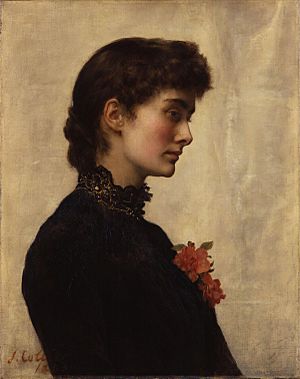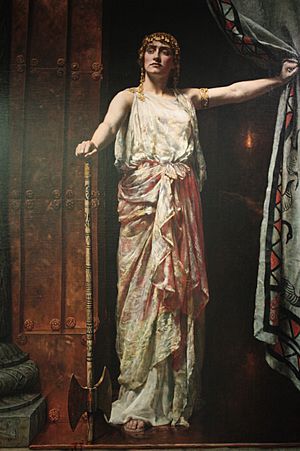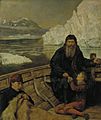John Collier (painter) facts for kids
Quick facts for kids
John Collier
OBE RP ROI
|
|
|---|---|

John Collier by his first wife Marian, née Huxley, 1882
|
|
| Born |
John Maler Collier
27 January 1850 Paddington, Middlesex, England
|
| Died | 11 April 1934 (aged 84) North House, Eton Avenue, London
|
| Education | Eton; Slade School of Fine Art |
| Known for | Painter |
| Movement | Pre-Raphaelite; Orientalist |
| Spouse(s) |
|
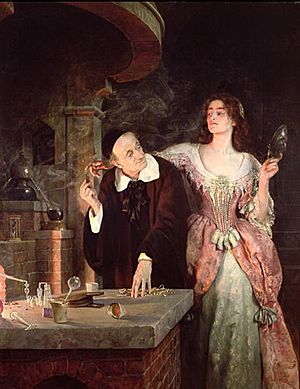
John Maler Collier (born January 27, 1850 – died April 11, 1934) was a talented British painter and writer. He was known for his beautiful portraits and painted in the Pre-Raphaelite style, which focused on detailed and colorful art. John went to Eton College and later studied painting in Paris and Munich, starting in 1875. He married two daughters of the famous scientist Thomas Henry Huxley.
Contents
Collier's Family Life
John Collier came from a very successful family. His grandfather, also named John Collier, was a Quaker merchant who became a member of Parliament. His father, Robert, was also a member of Parliament and later became a judge. He even had art studios in his home for John and his wife, Marion, to use. John's older brother was also an important public figure.
John Collier became very close to the family of Thomas Henry Huxley, a well-known scientist and president of the Royal Society. In 1879, John married Huxley's daughter, Marian (Mady). She was also a painter and studied at the Slade, just like John. Her paintings were shown in art exhibitions.
In 1881, John and Marian moved into a special studio house in Chelsea. They had one daughter named Joyce. Sadly, after Joyce was born, Marian became very ill and passed away in 1887. Joyce later became a talented artist herself, specializing in miniature portraits.
In 1889, John married Marian's younger sister, Ethel Huxley. At that time, it was not allowed to marry your deceased wife's sister in England. So, they had their wedding ceremony in Norway. John and Ethel had a daughter and a son, Sir Laurence Collier, who later became the British Ambassador to Norway.
Famous People John Collier Painted
John Collier painted many important people during his career. In 1893, he painted the Anglican Bishop of Shrewsbury, Sir John Lubbock, a famous scientist, and A.N. Hornby, a cricket captain.
He also painted members of the British Royal Family. These included the Duke of York (who later became George V) in 1901, and the Prince of Wales (who later became Edward VIII). The portrait of the Prince of Wales was displayed in a grand hall in India.
Other important people he painted included two Lord Chancellors (top legal officials), the Speaker of the House of Commons, and other senior judges.

Collier's subjects also included famous writers like Rudyard Kipling (1891) and artists like Sir Lawrence Alma-Tadema (1884). He painted many well-known actors of his time, such as J.L. Toole, Madge Kendal, Ellen Terry, and Herbert Beerbohm Tree.
He also painted leaders of famous universities like Balliol and Eton College. Military leaders like Field Marshal Lord Kitchener and two Indian maharajahs were also among his subjects.
Importantly, John Collier painted many scientists. These included Charles Darwin (1882), his father-in-law Thomas Henry Huxley (1891), and James Prescott Joule, who was famous for his work on energy. He painted a total of thirty-two portraits of the Huxley family over fifty years.
John Collier kept a special book called his Sitters Book. In it, he wrote down details about all the portraits he painted, including the person's name, the date, how much he was paid, and where the painting was shown. You can see a copy of this book at the National Portrait Gallery in London.
Collier's Art Style
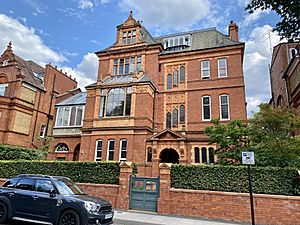
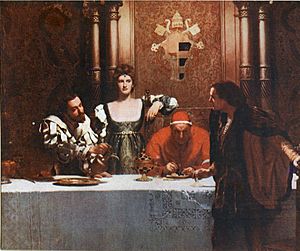
John Collier passed away in 1934. His art is sometimes compared to that of Frank Holl because some of his portraits of older men look very serious. However, his paintings of younger people, women, and children, as well as his "problem pictures" (which showed scenes from everyday life), are often very bright and lively.
Art experts have described his work in different ways. Some noted that his brush strokes were not very visible, making the paint look "flat." But they also praised his "strong and surprising sense of colour," which made his paintings feel very real in both mood and appearance. Another art book described his portraits as "painterly works with a fresh use of light and colour."
Where to See His Art
You can find many of John Collier's paintings in public art collections. Sixteen of his works are at the National Portrait Gallery in London, and two are at the Tate Gallery. In 1997, four of his paintings were on display at the National Portrait Gallery, including portraits of John Burns, Sir William Huggins, Thomas Huxley (his father-in-law), and Charles Darwin.
A self-portrait that John Collier painted in 1907 is kept in the Uffizi in Florence, Italy. This museum is famous for its collection of self-portraits by artists.
Other paintings by Collier can be seen in various houses and institutions that are open to the public. His large and impressive painting, Clytemnestra, is at the Guildhall Art Gallery in London. Another version of this painting is in the Worcester City Art Gallery & Museum. His painting Sentence of Death was given to the Wolverhampton Art Gallery by his widow.
His portrait of the Earl of Onslow (1903) is at Clandon Park in Surrey. His full-length portrait of Sir Charles Tertius Mander is at Owlpen Manor in Gloucestershire, and another version is at Wightwick Manor. His painting Lady Godiva is at the Herbert Art Gallery and Museum. You can also see "A glass of wine with Caesar Borgia" (1893) at Ipswich Town Hall.
Many reproductions of his works are available for viewing at the National Portrait Gallery's Heinz Archive and Library. A good selection of his art was also published in a book called The Art of the Honourable John Collier in 1914. His work was also featured in a major art exhibition in 1978.
Collier's Thoughts on Life and Morals
John Collier had interesting ideas about how people should live and what is right or wrong. He wrote a book called The Religion of an Artist. In this book, he explained that he believed in focusing on good behavior and kindness, rather than traditional religion.
He thought that people could be good and kind to each other without needing religious beliefs. He believed that being kind to others was a natural human feeling. He also felt that some religious ideas could cause arguments or be hard to understand with logic.
Gallery
See also
 In Spanish: John Collier para niños
In Spanish: John Collier para niños
- List of Pre-Raphaelite paintings – including the work of John Collier


